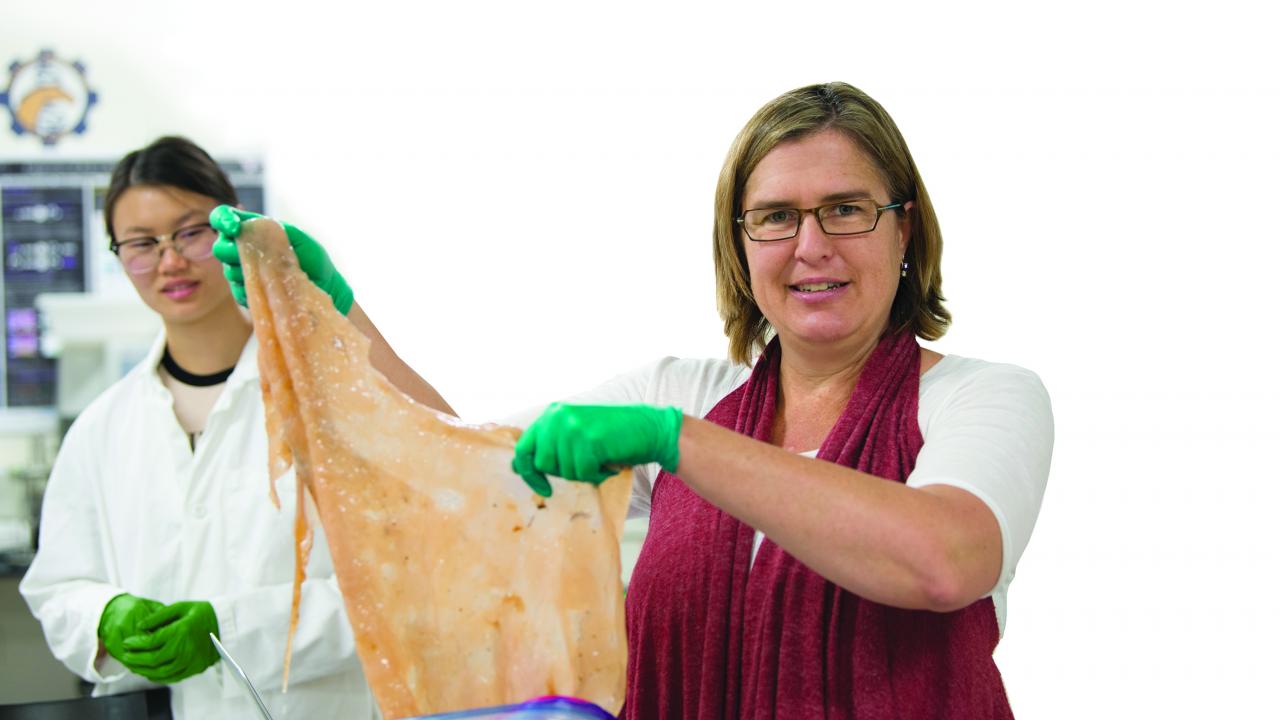
BioDesign Lab: Kombucha, Fashion and Sustainable Design
Dressed in white lab coats, students examine petri dishes containing a gooey, fleshy substance they’ve been growing. Starting with kombucha made from green tea and symbiotic colonies of yeast and bacteria, or SCOBYs, the petri dishes issue forth a microbial cellulose that can be used like fabric sometimes dubbed “vegan leather.”
In “BioDesign Theory and Practice,” students get hands-on experience with materials like kombucha culture to learn about sustainable design practices that explore alternatives to the use of plantand animal-based materials, which can take a toll on the environment through energy, water and pesticide use.
“This is possibly the first design class at UC Davis to have a biological lab component,” said Christina Cogdell, design professor and department chair, who taught the class with Marc Facciotti, a UC Davis biomedical engineering professor. “But it isn’t just about kombucha—it teaches students about a wide range of design materials and new ways to think about materials. We are looking at ways forward using bio-based materials and alternatives to petroleum-based products and those that use a lot of energy to manufacture.”
Students learn about the latest trends in sustainable design through research and teaching in energy-efficient lighting, natural dyes and using recycled material like wood pulping waste in 3-D printing.
“If they want to work in this area, they need time in the lab,” Cogdell said. “Some of them were a little scared going into the lab, but they overcame the fear and got a new experience.”
In the lab these students may deal with issues they’ve never faced in a design class.
“One of the things you have to decide: do you want it living or do you want to kill it first?” Cogdell said while walking though the Bio-Innovation Teaching Lab. And if the material needs to be alive, students need to learn how to edit its DNA to make it resistant to antibiotics found in many dyes.
Junior design major Rael Hanus, like many students in the class, was in a lab for the first time since high school.
“This isn’t something most designers are exposed to,” Hanus said. “As a designer—especially at a school like Davis where we are the leaders in sustainable efforts—I definitely feel a responsibility to design with purpose and be conscious of how my designs will impact people and our environment. Biodesign really allowed me to see the potential that designers have for creating products that will make a difference in the world and not just contribute to needless consumerism.”
For Elisabeth McAllister, a third-year design major, the class changed her career focus.
“Designing sustainable systems and products is possible—in fact, more than possible. It is essential to the conservation of a world based on equality and balance,” she said. “Watching the dance of science working with art gave me hope that there are designers out there like me who refuse to be pushed into the traditional categories of design. The future of design is here and is taking place at UC Davis.”
Moving forward, Cogdell and Facciotti hope to make the class more integral to the sustainable design and biomedical engineering curricula. Next year they plan to enter the class projects in the BioDesign Challenge Competition, an international summit where the top teams present at the Museum of Modern Art in New York.
— Jeffrey Day, content strategist in the UC Davis College of Letters and Science
